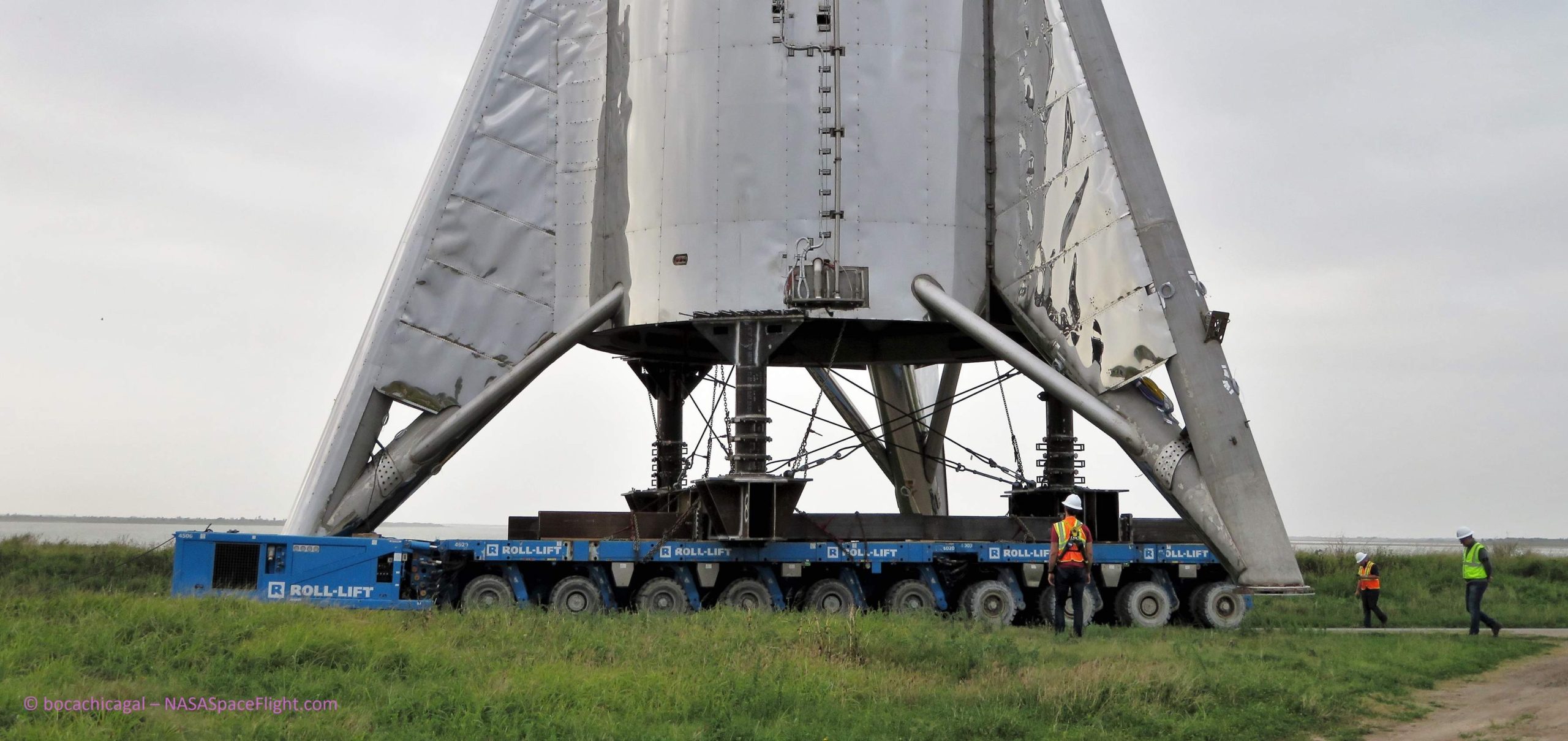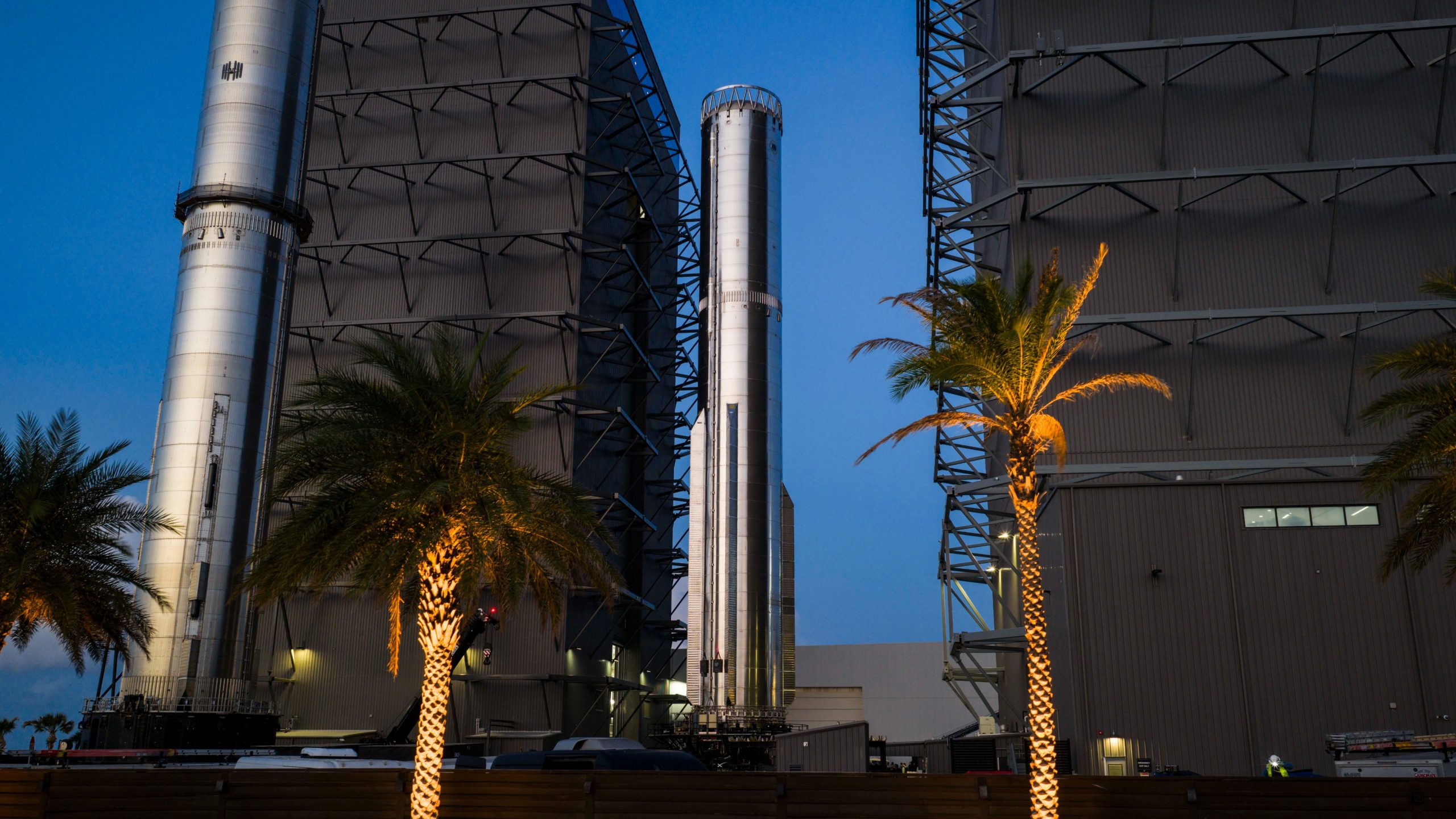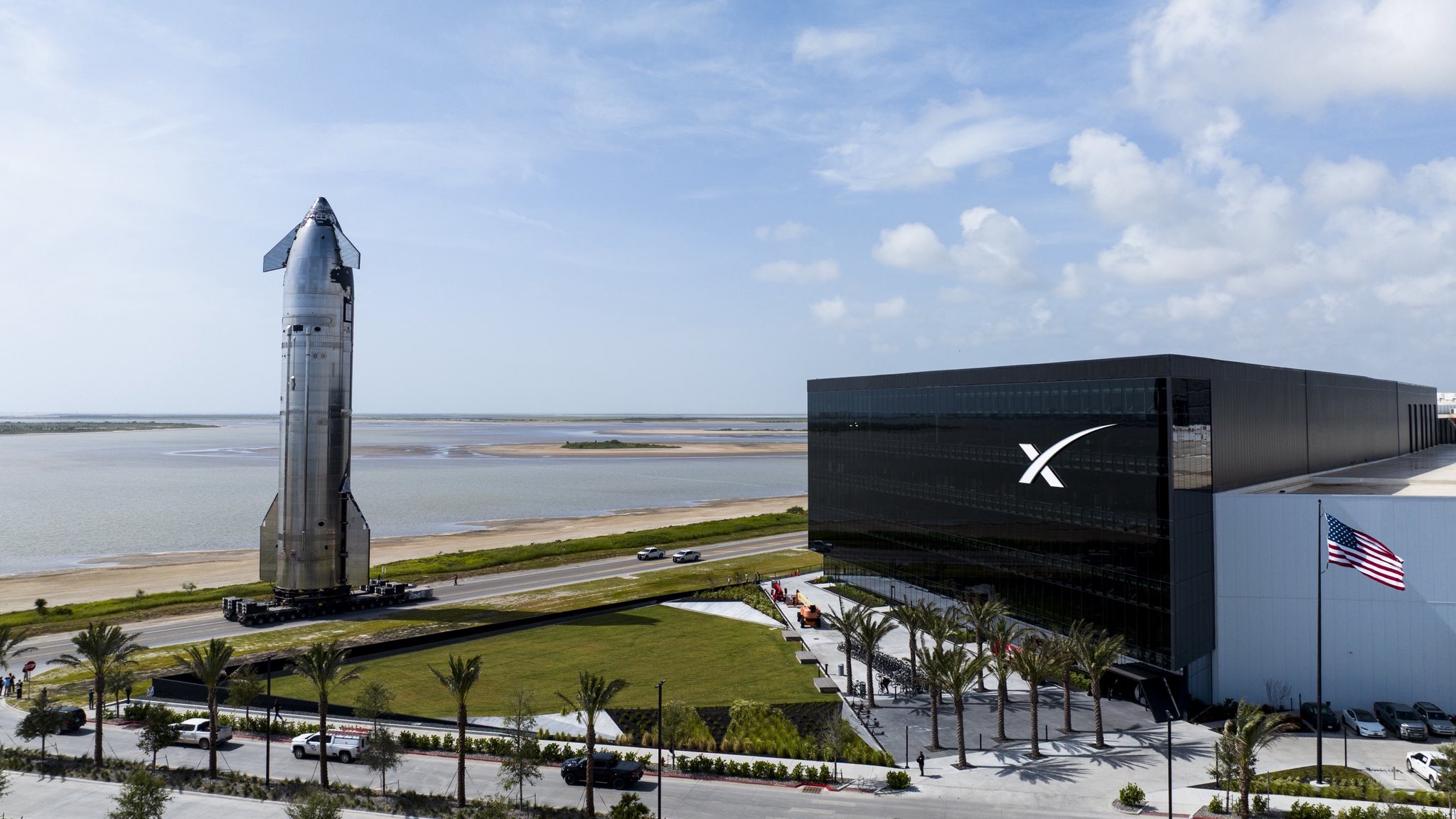

SpaceX
SpaceX’s Starship prototype moved to launch pad on new rocket transporter
Over the last two or so weeks, SpaceX engineers and technicians have continued to make progress on the company’s first full-scale Starship prototype, intended to support experimental suborbital hop tests as early as March or April.
That work reached a peak on March 8th when the massive Starhopper was transported from build site to launch pad on a brand new transporter that was delivered and assembled barely 48 hours prior. Ahead of the suborbital prototype’s move, work has been ongoing to construct a replacement fairing for the partial-fidelity vehicle, although there is a chance that the new BFR-related stainless steel sections being assembled could be the start of the first orbital Starship prototype.
Required after improper planning destroyed Starship’s original nosecone (or fairing) when it broke free from its insufficient moorings during high coastal winds, the replacement has sprouted from sheets of metal into a far more substantial structure in barely two weeks. Designed as two integral parts of a suborbital Starship prototype, the upper section (i.e. fairing, nosecone, etc.) is predominately a passive aerodynamic structure with no major active functions, thankfully meaning that the first article’s accidental destruction was a relatively minor loss.
In fact, it’s entirely possible that the fairing’s demise has had a minimal impact on the commencement of hop tests, and may have even been a net-good for the program given some visible differences between Starship fairings #1 and #2. Despite the fact that the first fairing was destroyed in late January and a comment from CEO Elon Musk indicating that it would trigger a delay of a few weeks, SpaceX did not begin to assemble its replacement until February 21st, a full month later. Over the course of those 30 or so days, the company’s propulsion team simultaneously began hot-fire tests of the first full-scale Raptor engine, ramped thrust and chamber pressure from roughly 40 to 100 percent, and ultimately pushed the engine to the point of damage around the second week of February.
Work on the primary structure of the Starship prototype also proceeded apace, fleshing out the brute-force steel vehicle with the beginnings of serious avionics and plumbing and more or less completing the structure of its liquid oxygen and methane propellant tanks. SpaceX workers also rapidly expanded and built-out Starship’s prospective hop test launch pad just a few thousand feet distant, installing tank farms, piping, water deluge hardware, and building an actual concrete ‘pad’ with umbilical connection ports and attachment points for the ship’s three fin-legs.

Welding and assembly of the replacement nosecone began around February 21st, rapidly growing from a few sheets of steel to a nearly-complete barrel section measuring about 9m tall and 9m in diameter (30ft x 30ft). Intriguingly, the new fairing appears to be a significant departure from the structural composition of its predecessor, utilizing far thicker sheets of stainless steel joined by uninterrupted width and lengthwise welds. Compared to the first fairing’s dependence on extremely thin (nearly foil-like) steel sheets and a separate internal framework of metal bars, Starship fairing V2 appears to be easily capable of standing under its own weight and then some. While largely passive, it’s likely that once the structure is complete, some level of additional avionics (and perhaps cold or hot-gas maneuvering thrusters) will be installed inside.
Heres a close up of the launch site. pic.twitter.com/Q32SHjUH8F— RGVAerialPhotography (@RGVaerialphotos) March 4, 2019
U-Crawl
Keeping in the practice of dramatically lowering costs by prioritizing consumer off-the-shelf (COTS) hardware solutions wherever possible, SpaceX has purchased or leased a quartet of (likely used) crawlers for the purpose of transporting Starship between the company’s South Texas build, launch, and landing sites. Built by a European conglomerate known TII Group and owned by US-based Roll Group, SpaceX’s four crawlers – coupled to form a duo of larger crawlers – should be more than capable of transporting anywhere from 500t to 1000t or more, easily supporting Starhopper and/or Starships and Super Heavy boosters.

Rather than spending huge amounts of money to develop or contract out a custom-designed crawler or transporter solution for BFR, SpaceX appears to have simply purchased off-the-shelf hardware and affixed them with heavy steel structures capable of securing and supporting Starhopper during transport. Within 24 hours of the crawler arrivals, those beams were installed and the transporter had been moved underneath Starhopper and attached to it before quite literally jacking the massive ship off the ground, allowing technicians to weld additional structures to the tips of its three legs.

Last but not least…
Perhaps most curious of all, Starhopper’s replacement fairing was recently joined by the start of work on a separate barrel section that appears to be nearly identical. Assuming the presumed fairing is, in fact, a fairing-to-be, the combined height of the two barrel sections would already make it significantly taller than the original nosecone, and the beginning of the conical taper has yet to appear on either assembly. This could generally mean one of two things. First, the new fairing could make Starhopper much taller than its short-lived predecessor. Second, SpaceX could be planning to begin (or even complete) hop tests without a fairing, in which case the presumed fairing and its slightly younger twin could actually be the beginning of a higher-fidelity Starhopper or even the orbital Starship prototype hinted at by Musk earlier this year.
While far less likely than the first option, the latter alternative is further supported by the fact that visible work has begun on some sort of tapered or curved steel complements to the new sections in work. While they certainly could be the beginning of the fairing’s tapered cone, the latest segments only loosely resemble the start of a gradual curve. Instead, they look similar to the steel segments of several giant tank domes that were assembled, welded, and installed inside Starhopper last month.


On March 8th, SpaceX began the transport of its first full-scale Starship prototype at the same time as CEO Elon Musk indicated that the first flightworthy Raptor(s) would be delivered to South Texas and installed on the hop test article as early as next week (March 11-17). It’s now looking increasingly likely that any replacement fairing that may or may not be under construction might not be ready for installation on Starhopper before SpaceX begins integrated static-fire tests and maybe even low-altitude tethered hop tests.
“SpaceX will conduct checkouts of the newly installed ground systems and perform a short static fire test in the days ahead,” he said. “Although the prototype is designed to perform sub-orbital flights, or hops, powered by the SpaceX Raptor engine, the vehicle will be tethered during initial testing and hops will not be visible from offsite. SpaceX will establish a safety zone perimeter in coordination with local enforcement and signage will be in place to alert the community prior to the testing.” – James Gleeson, March 8th, SpaceX
Check out Teslarati’s Marketplace! We offer Tesla accessories, including for the Tesla Cybertruck and Tesla Model 3.

Elon Musk
SpaceX issues statement on Starship V3 Booster 18 anomaly
The incident unfolded during gas-system pressure testing at the company’s Massey facility in Starbase, Texas.

SpaceX has issued an initial statement about Starship Booster 18’s anomaly early Friday. The incident unfolded during gas-system pressure testing at the company’s Massey facility in Starbase, Texas.
SpaceX’s initial comment
As per SpaceX in a post on its official account on social media platform X, Booster 18 was undergoing gas system pressure tests when the anomaly happened. Despite the nature of the incident, the company emphasized that no propellant was loaded, no engines were installed, and personnel were kept at a safe distance from the booster, resulting in zero injuries.
“Booster 18 suffered an anomaly during gas system pressure testing that we were conducting in advance of structural proof testing. No propellant was on the vehicle, and engines were not yet installed. The teams need time to investigate before we are confident of the cause. No one was injured as we maintain a safe distance for personnel during this type of testing. The site remains clear and we are working plans to safely reenter the site,” SpaceX wrote in its post on X.
Incident and aftermath
Livestream footage from LabPadre showed Booster 18’s lower half crumpling around the liquid oxygen tank area at approximately 4:04 a.m. CT. Subsequent images posted by on-site observers revealed extensive deformation across the booster’s lower structure. Needless to say, spaceflight observers have noted that Booster 18 would likely be a complete loss due to its anomaly.
Booster 18 had rolled out only a day earlier and was one of the first vehicles in the Starship V3 program. The V3 series incorporates structural reinforcements and reliability upgrades intended to prepare Starship for rapid-reuse testing and eventual tower-catch operations. Elon Musk has been optimistic about Starship V3, previously noting on X that the spacecraft might be able to complete initial missions to Mars.
Elon Musk
SpaceX Starship Version 3 booster crumples in early testing
Photos of the incident’s aftermath suggest that Booster 18 will likely be retired.

SpaceX’s new Starship first-stage booster, Booster 18, suffered major damage early Friday during its first round of testing in Starbase, Texas, just one day after rolling out of the factory.
Based on videos of the incident, the lower section of the rocket booster appeared to crumple during a pressurization test. Photos of the incident’s aftermath suggest that Booster 18 will likely be retired.
Booster test failure
SpaceX began structural and propellant-system verification tests on Booster 18 Thursday night at the Massey’s Test Site, only a few miles from Starbase’s production facilities, as noted in an Ars Technica report. At 4:04 a.m. CT on Friday, a livestream from LabPadre Space captured the booster’s lower half experiencing a sudden destructive event around its liquid oxygen tank section. Post-incident images, shared on X by @StarshipGazer, showed notable deformation in the booster’s lower structure.
Neither SpaceX nor Elon Musk had commented as of Friday morning, but the vehicle’s condition suggests it is likely a complete loss. This is quite unfortunate, as Booster 18 is already part of the Starship V3 program, which includes design fixes and upgrades intended to improve reliability. While SpaceX maintains a rather rapid Starship production line in Starbase, Booster 18 was generally expected to validate the improvements implemented in the V3 program.
Tight deadlines
SpaceX needs Starship boosters and upper stages to begin demonstrating rapid reuse, tower catches, and early operational Starlink missions over the next two years. More critically, NASA’s Artemis program depends on an on-orbit refueling test in the second half of 2026, a requirement for the vehicle’s expected crewed lunar landing around 2028.
While SpaceX is known for diagnosing failures quickly and returning to testing at unmatched speed, losing the newest-generation booster at the very start of its campaign highlights the immense challenge involved in scaling Starship into a reliable, high-cadence launch system. SpaceX, however, is known for getting things done quickly, so it would not be a surprise if the company manages to figure out what happened to Booster 18 in the near future.
Elon Musk
SpaceX’s next project will produce Starships at a level that sounds impossible
1,000 rockets per year is an insane number, especially considering Starship’s sheer size.

Elon Musk has revealed bold plans for SpaceX’s newest Starbase facility in Texas, predicting it will become a birthplace for “so many spaceships.” The upcoming “Gigabay,” a massive $250 million production hub in Starbase, Texas, is designed to manufacture up to 1,000 Starship rockets per year.
That’s an insane number of rockets for a single facility, especially considering Starship’s sheer size.
One of the world’s largest industrial structures
SpaceX’s Gigabay is expected to stand roughly 380 feet tall and enclose 46.5 million cubic feet of interior space, making it one of the largest industrial structures to date. The facility will feature 24 dedicated work cells for assembling and refurbishing Starship and Super Heavy vehicles, complete with heavy-duty cranes capable of lifting up to 400 U.S. tons, as noted in a Times of India report.
Construction crews have already placed four tower cranes on-site, with completion targeted for December 2026. Once operational, the Gigabay is expected to boost SpaceX’s launch cadence dramatically, as it would be able to build up to 1,000 reusable Starships per year, as noted in a report from the Dallas Express. Musk stated that the Gigabay will be “one of the biggest structures in the world” and hinted that it represents a major leap in Starbase’s evolution from test site to full-scale production hub.
A key step toward Mars and beyond
Starship is SpaceX’s heavy-lift rocket system, and it remains a key part of Elon Musk’s vision of a multiplanetary future. The vehicle can carry 100–150 tonnes to low Earth orbit and up to 250 tonnes in expendable mode. With several successful flights to date, including a perfect 11th test flight, the Starship program continues to refine its reusable launch system ahead of crewed lunar missions under NASA’s Artemis initiative.
Starship is unlike any other spacecraft that has been produced in the past. As per Elon Musk, Starship is a “planet-colonizer” class rocket, as the magnitude of such a task “makes other space transport task trivial.” Considering Starship’s capabilities, it could indeed become the spacecraft that makes a Moon or Mars base feasible.








